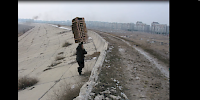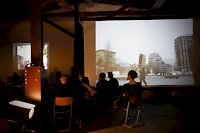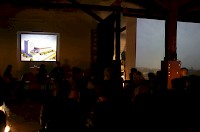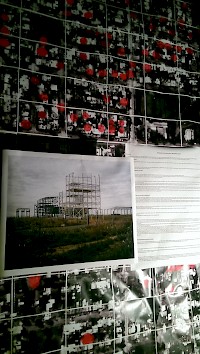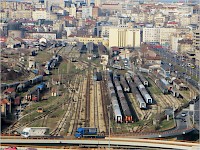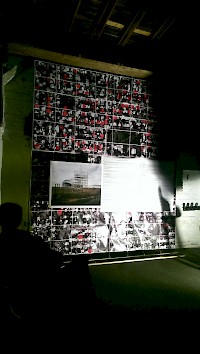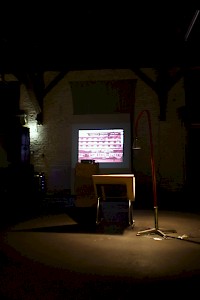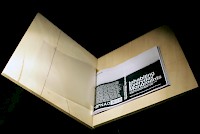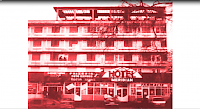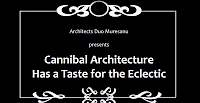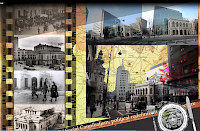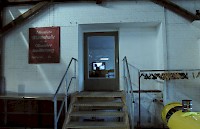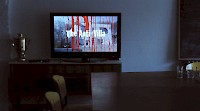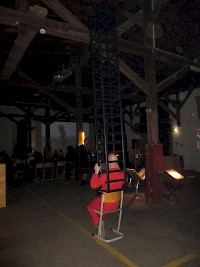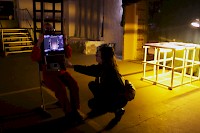Exhibition
DEVOUR! part II, Berlin
Sozialer Kannibalismus, politische Neudefinierung und Architektur
25th -27th March 2015
Zentrum für Kunst und Urbanistik (ZK/U)
Artists: Jordi Colomer, Architects duo Muresanu, Matias Machado, Vladimir US, Andrej Mircev, Srdjan Jovanovic Weiss with Philip Plowright, Failed Architecture, Patrick Jambon, Arno Brandlhuber + Christopher Roth, Patrick Jambon.
Dramaturgy and Moderation: Andrej Mircev .
Curator: Marta Jecu
DEVOUR part II AT ZK/U Berlin, exhibition/Screenings/Symposium/Performance, 25th March 2015 - 27th March
DEVOUR II is shifting the focus from an artists' exhibition to a collection of archive and research material by architects, curators and researchers, that discuss and show their visual material, gathered during various year's of research. These will be presented during a conference and shown in an exhibition at ZK/U. Each of them will present a case study on recent paradigmatic phenomena on the East-West axis where we can talk about architectural phenomena of anthropophagy. The problematic and often deficit assimilation of the consequences which the fall of the Iron Curtain left behind in Eastern Europe and the Balkans are being followed up in these contributions of local experts: architects, professors, urbanists. Their years-long researches took the shape of texts and photography, sometimes also material that they filmed along with their interviews. Shown together, they reveal how political and cultural cannibalistic acts and their consequences on architecture follow economical dictates. After the fall of communism the disparity of means and the hypocrisy of political discourse reinforced the mutations which were caused by the communist dictatorships. These were again aligned to macroeconomic, global toxic structures, without considering the specificity of each national economic situation. Nevertheless, on a micro-level, these mutations can carry also a regenerative force. Fueled by creative reactions, they can change thinking patterns and create commitment to new historic paradigms.
The exhibition traces back hybrid cases of Eastern European architecture in Romania, Moldavia, Croatia and Serbia, results of political, ideological and economical upheaval and the legal disparities that they left behind. Urbanistic patologies in postcommunism are exposed uncensured in decaying buildings and ruined landscapes. How can we reassess the desintegration of historic architecture in the context of Eastern Euopean neoliberal economy? Which are the perspectives in the fight against aggressive public space occupation and abusive annexations, operated by private corporations due to corruption in the urban administration?
The work of Vladimir US talks about the commercialization of public space. His case study Bulevardul Cantemir (Cantemir Avenue), a public street in Chisinau, Moldavia was conceived in the 1970's as an ideological communist project, meant to showcase the progress and improvements of communism. The boulevard was supposed to replace a huge part of the old city. Fortunately these massive demolitions did not take place due to economic reasons and only a part of it was built. Today the missing part is replaced with an improvised shopping mall and was turned into a commercial area for investors. A similar situation happened in Bucharest with the Piata Buzesti, where a historic and functional market place was turned into a commercial area for big entreprises. The neighborhood where it was placed was destroyed and partially demolished and the population was evacuated in order to make way for hastily planned commercial projects.
Together with 8 architecture teams of the Lawrence Technological University, the architects Srdjan Jovanovic Weiss and Philip Plowright conceived and edited the book Inhabiting Everyday Monuments, (Lulu, 2014). In students' contributions and in experimental drawings and diagrams, the book elaborates on destroyed, almost post-apocalyptic landscapes, imagining forms of living and dwelling. The book crosses various environments from the Detroit, Flint and Michigan post industrial remains to socialistic monuments in Ex-Jugoslavia. The last ones lye abandoned in the landscape in Serbia, devoid of any meaning. Their modernistic-socialistic aesthetic lets them seem almost a curiosity to the foreign eye. The architectural teams involved in Inhabiting Everyday Monuments experiment in archaeologically digging in these forms, extracting a new meaning and recycling for contemporary needs this patrimony.
In the installation of Andrej Mircev consisting of six light boxes, images, fragments of objects, typographic rests are all mixed by the artist and curator into slides, which bring the viewer close to the industrial landscape of Croatia. Mircev has visited with his group of students a ruined communist factory in Rijeka. He found here the original archive of the factory and brought fragments of documents and other found material together in these dia-collages. The ghost life of an exhausted communist working class with their often oppressive and now deserted archives, becomes a symptomatic image. This superpositions of past temporal cycles with the lifes that they brought about, are visible in these lightboxes.
As part of the large research body of the international team Failed Architecture, Maja Popovic and Mark Minkjan confront with the Belgrade waterfront – an 2014 initiated project of the Serbian Government with investment from the Emirates. This megalomaniac, yet unbuilt project is an example of corrupt urban space appropriation and illegal real estate speculation. The investigative project of Failed Architecture shows that urban development can be used as a profit machine, especially using the legal cracks that appeared in post-communist Europe. Failed Architecture pleads for a urbanistic practice that is responsible towards the population and towards the genius loci.
The Romanian architect-duo Muresanu shows historic buildings, which have been literally cannibalized by newer architectures. As a consequence of forced demolitions in communist Bucharest, fragments of historic buildings or houses in a ruined state stand often alone in open areas, without any context or surrounded by newer buildings, in the city center. Often these old buildings are being rebuilt or completed with 'modern' additions and not seldom the reason is the interest to profit the central terrain, disregarding common urbanistic principles. These new forms hastily built and engulfing the old buildings, engage precarious materials are not practical and not thought for the necessities of their inhabitants.
Christopher Roth stages a poetic food spiced with cannibalistic motives at the Anti-Villa – a private house in Krampnitz, built by the German architect Arno Brandlhuber. Christopher Roth's video interweaves in the contemporary happenings also parts of the film Themroc by Claude Faraldo, 1973, which constituted the initial and central inspiration of the entire DEVOUR! Project. Themroc emerged out of France's 1960s leftist oriented movements. The main character, which is caught up in a late-bourgeois living situation, gives up one day articulated language and destroys the walls of his flat turning it into a cave. He starts an anarchic orgy, which culminates with the devoration of a policeman and incest with his sister. Arno Brandlhuber's Anti-Villa carries all this symbolic capital of Themroc's destroyed architecture in an abstract coating and is reframed again by the video of Christopher Roth with a contemporary melancholic distance.
The work of Vanessa Ramos Velasquez is the result of her long year researches to what she calls 'digital anthropophagy'. The artist born in Brazil follows in her work a paradigmatic Brazilian architecture: the hammock. Similar to the encampment structure of Pedro Valdez Cardoso, this temporary architecture, transports also an indigenous way of living, before the colonial time. The work of Vanessa Ramos Velasquez includes also a collection of drawings and prints with representations of hammocks and the meaning with which these are associated in the exotic-greedy eyes of the Europeans. Ramos Velasquez builds a digital hammock-structure: three cameras which are fixed on a tripod record the approximation of the visitors and metabolizes the subjects into a digital live-image.
Patrick Jambon brings, similar to Jordi Colomer, a perfromative dimension to architecture. Between virtual and concrete, digital projection, model and toy, he fixes an architectonic structure on his body and interacts with the viewers, with the intermediation of a game machine. His performance during which the 2 meters tower was balancing on his body, lasted through the opening night.
A performative culinary event, 'The Consumed Dinner', was being conceived for the opening night by the food and performance artist Caroline Hobkinson. The food was prepared in situ for the exhibition participants and the public on open fire and celebrated the 1st May Walpurgisnacht, when the opening took place. The remains of the dinner were installed in the exhibition space into a transformative, ephemeral structure: the food was rotting, seeds were growing into green plants and the table landscape was changing continuously during the exhibition time. Eating rituals and invented eating tools, which generated new eating practices, reproduce a social digestive structure which should be promoted to continuously renovate itself. The piece stayed as a sort of memento mori in a vivid vanitas scene – a sort of symbol of the entire project.
Text: Marta Jecu
Many thanks to Anna Jäger for the translation of parts of this text and to Andrej Mircev for the consistent collaboration at the text and exhibition conception.
***
DEVOUR! III ist part 3 of a project that included also following events:
DEVOUR part I: Freies Museum (www.freies-museum.com/) in collaboration with Savvy Contemporary (www.savvy-contemporary.com): 21st March – 15th April
DEVOUR part III at Kunstkraftwerk Leipzig (www.kunstkraftwerk-leipzig.com): 30th April - 4th June.
***
This project has been supported by Kulturstiftung des Freistaates Sachsen, Niederlandische Botschaft, Bristish Council, Accion Cultural Española, Fundação Calouste Gulbenkian,Rumänisches Kulturinstitut Berlin, Cicant, Serendipity Films, Mission Statement, Z/KU Berlin, Savvy Contemporary, Lichtblick Kino und KKW Leipzig
